
Artemisia is a large, diverse genus of plants belonging to the daisy family Asteraceae, with between 200 and 400 species. Common names for various species in the genus include mugwort, wormwood, and sagebrush.
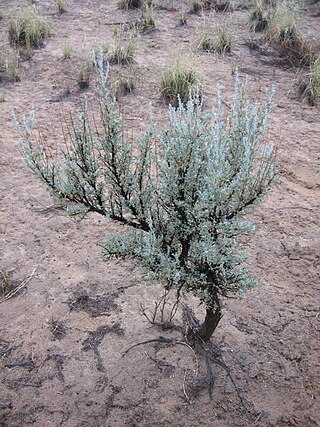
Artemisia tridentata, commonly called big sagebrush, Great Basin sagebrush or (locally) simply sagebrush, is an aromatic shrub from the family Asteraceae, which grows in arid and semi-arid conditions, throughout a range of cold desert, steppe, and mountain habitats in the Intermountain West of North America. The vernacular name "sagebrush" is also used for several related members of the genus Artemisia, such as California sagebrush.
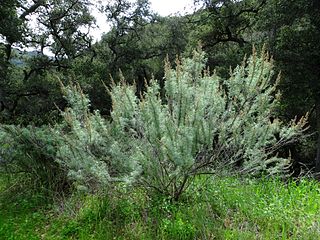
Artemisia californica, also known as California sagebrush, is a species of western North American shrub in the sunflower family.

Artemisia arbuscula is a North American species of sagebrush known by the common names little sagebrush, low sagebrush, or black sagebrush. It is native to the western United States from Washington, Oregon, and California east as far as Colorado and Wyoming. It grows in open, exposed habitat on dry, sterile soils high in rock and clay content.

Artemisia bigelovii is a North American species of sagebrush known by the common name Bigelow sagebrush or flat sagebrush. It grows in the deserts of the southwestern United States.

Artemisia nova is a North American species of sagebrush, known by the common name black sagebrush. It is "one of the most common shrubs in the western United States".

Artemisia rothrockii is a North American species of sagebrush known by the common names timberline sagebrush and Rothrock's sagebrush.

Artemisia spinescens is a North American species of sagebrush in the sunflower family, known by the common name budsage.
Crepis pleurocarpa is a North American species of flowering plant in the family Asteraceae known by the common name nakedstem hawksbeard. It is native to the western United States (Washington, Oregon, northern California and western Nevada.

Orobanche californica, known by the common name California broomrape, is a species of broomrape. It is a parasitic plant growing attached to the roots of other plants, usually members of the Asteraceae.

Orobanche fasciculata is a species of broomrape known by the common name clustered broomrape. It is native to much of western and central North America from Alaska to northern Mexico to the Great Lakes region, where it grows in many types of habitat. It is a parasite growing attached to the roots of other plants, usually members of the Asteraceae such as Artemisia; and other genera such as Eriodictyon and Eriogonum. This plant produces one or more stems from a bulbous root, growing erect to a maximum of about 20 centimeters in height. The stems, leaves and five-lobed flowers are covered by sticky hairs. As a parasite taking its nutrients from a host plant, it lacks chlorophyll as well as a water-storage system. It is variable in color, often yellowish or purple. The inflorescence is a raceme of up to 20 flowers, each on a pedicel up to 15 centimetres long. Each flower has a calyx of hairy triangular sepals and a tubular corolla 1.5–3 cm long. The flower is yellowish or purplish in color.

Nestotus stenophyllus is a species of flowering plant in the family Asteraceae known by the common name narrowleaf mock goldenweed. It was previously known as Stenotus stenophyllus. It is native to the western United States, especially the inland Pacific Northwest and northern Great Basin, where it grows in sagebrush habitat usually in rocky soil.

Schoenocrambe argillacea is a rare species of flowering plant in the mustard family known by the common names clay reed-mustard, Uinta Basin plainsmustard, and clay thelypody.
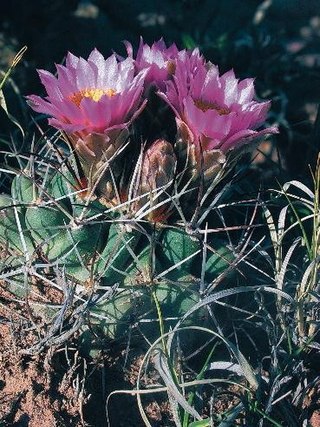
Sclerocactus glaucus is a rare species of cactus known by the common name Colorado hookless cactus. It is endemic to Colorado in the United States, where it is known only from the area between Grand Junction and Montrose. It is a federally listed threatened species.
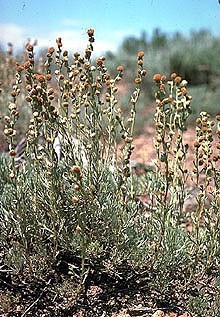
Artemisia papposa is a species of flowering plant in the aster family known by the common names Owyhee sage, Owyhee sagebrush, and fuzzy sagebrush. It is native to the Snake River Plain and surrounding areas in the northwestern United States, occurring in southern Idaho, eastern Oregon, and northern Nevada.

Artemisia filifolia, known by common names including sand sagebrush, sand sage and sandhill sage, is a species of flowering plant in the aster family. It is native to North America, where it occurs from Nevada east to South Dakota and from there south to Arizona, Chihuahua, and Texas.
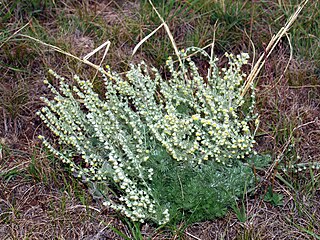
Artemisia frigida is a widespread species of flowering plant in the aster family, which is known as the sunflower family. It is native to Europe, Asia, and much of North America. In parts of the north-central and northeastern United States it is an introduced species.

Artemisia pedatifida is a species of flowering plant in the aster family known by the common names birdfoot sagebrush and matted sagewort. It is native to a section of the west-central United States encompassing parts of Idaho, Montana, Wyoming and Colorado, where it occurs on the high plains.

Artemisia rigida is a species of flowering plant in the aster family known by the common names scabland sagebrush and stiff sagebrush. It is native to the northwestern United States, in Washington, Idaho, and Oregon. It has been recorded in western Montana but these sightings may have been misidentifications.

Cirsium perplexans is a species of flowering plant in the family Asteraceae known by the common names Rocky Mountain thistle and Adobe Hills thistle. It is endemic to Colorado in the United States, where it occurs in the Colorado and Gunnison River Valleys in the Rocky Mountains.




















